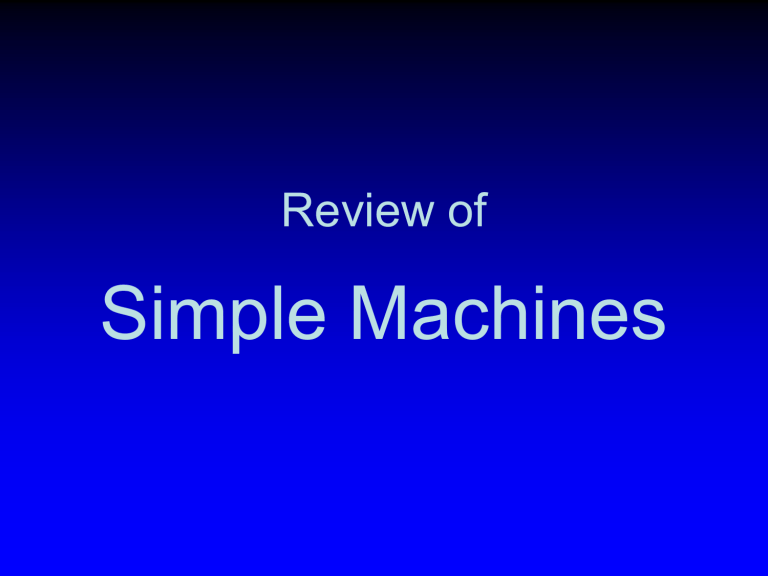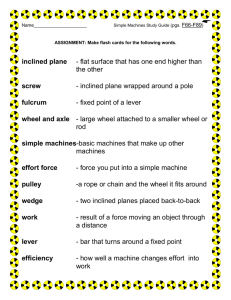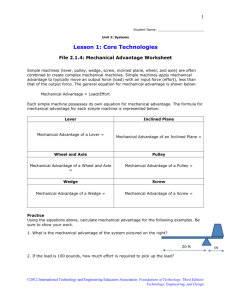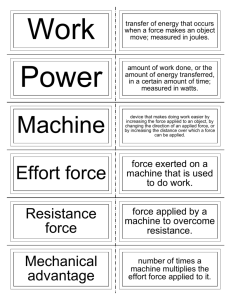Simple Machines Review

Review of
Simple Machines
What are they?
Simple machines are machines with few or no moving parts that are used to make work easier
Why Simple Machines?
For the mechanical advantage …
• Making something easier to do, but it takes a little longer to do it
• For example, going up a longer flight of stairs instead of going straight up a ladder
Types of Simple Machines
Wedge
Wheel and Axle
Lever
Inclined Plane
Screw
Pulley
Wedge
• Pushes materials apart, cuts things
• Examples: axe, doorstop, chisel, nail, saw, jackhammer, bulldozer, snow plow, horse plow, zipper, scissors, airplane wing, knife, fork, bow of a boat or ship
Wheel and Axle
• Makes it easy to move things by rolling them, and reducing friction
• Examples: car, bicycle, office chair, wheel barrow, shopping cart, hand truck, roller skates
Screw
• Turns rotation into lengthwise movement
• Takes many twists to go a short distance
• Holds things together
• Examples: screws, bolts, clamps, jar lids, car jack, spinning stools, spiral staircases
Pulley
• Makes lifting things with a rope easier by redirecting force and the addition of additional pulleys
• Examples: flag pole, elevator, sails, fishing nets, clothes lines, cranes, window shades and blinds, rock climbing gear
Complex Machines
• Combining two or more simple machines to work together
• Examples:
– Car jack combines wedge and screw
– Crane or tow truck combines lever and pulley
– Wheel barrow combines wheel & axle with a lever
– Axe combines wedge with a lever
Mechanical Advantages
Wedge
Wheel and axle
Lever
Inclined plane
Screw
Pulley
Pushes material apart, cuts
Makes it easy to move objects by rolling them, and reducing friction
Helps lift heavy weights using longer distances
Makes it easier to move objects upward; a longer path but easier lifting
Turns rotation into lengthwise movement
Makes lifting heavy objects easier by redirecting force
Engineering Design Process
— Steps —
• Understand the need:
What is the problem? What do I want to do? What are the project requirements? What are the limitations? Who is the customer? What is the goal?
Gather information and research.
• Brainstorm and design:
Imagine and brainstorm ideas. Be creative.
Investigate existing technologies and methods to use. Explore, compare and analyze many possible solutions. Select the most promising idea.
• Plan:
Draw a diagram of your idea. How will it work? What materials and tools are needed?
How will you test it to make sure it works?
• Create:
Assign team tasks. Build a prototype. Does it work?
Talk about what works, what doesn’t and what could work better.
• Improve:
Talk about how you could improve your end product. Make revisions. Draw new designs. Make your end product the best it can be.
References
• All images © Copyright © 2004 Microsoft Corporation, One Microsoft Way, Redmond,
WA 98052-6399 USA. All rights reserved.
• Except for images below, which were created by the ITL Program, College of
Engineering and Applied Science, University of Colorado at Boulder, sometimes using
Microsoft clip art.






